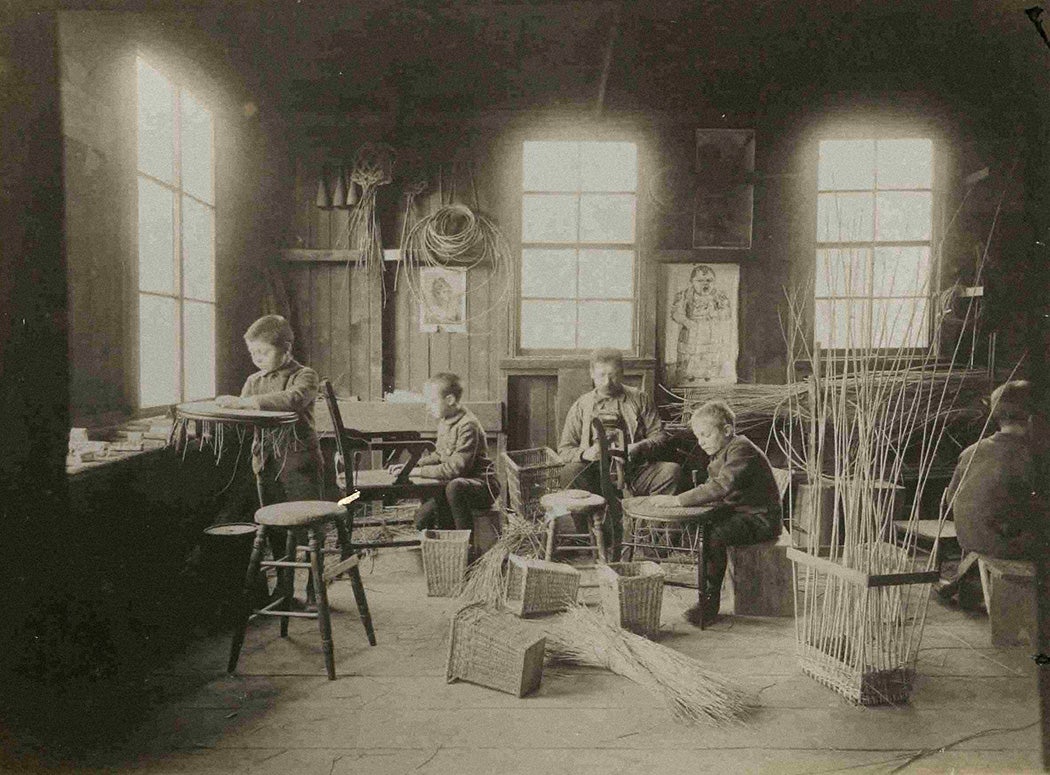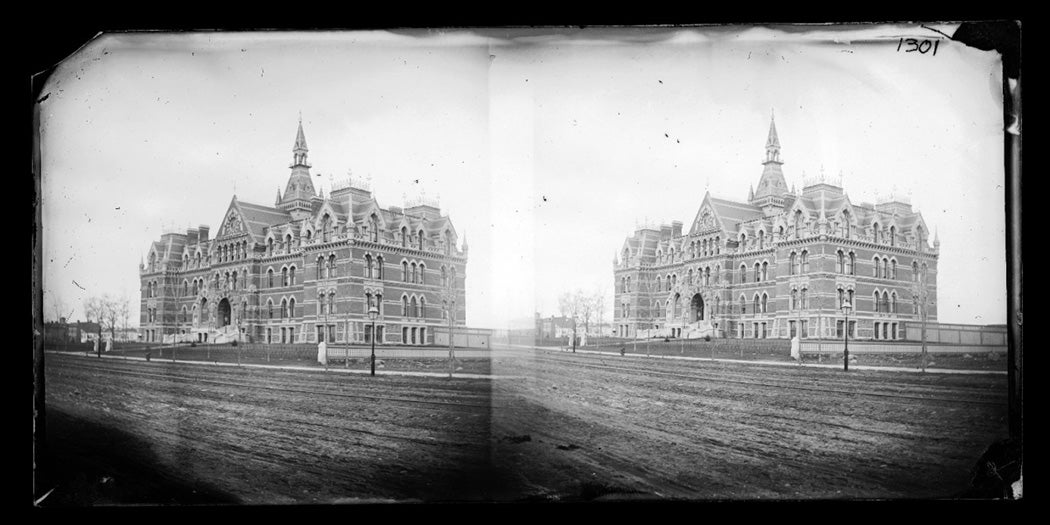A photo of a two-year-old Ukrainian girl shocked millions around the world earlier this year. Vira Makoviy’s name was written across the small of her back along with her birthday and emergency contacts. Her mother had hurriedly marked it there, thinking that should she herself perish, her daughter could be identified and connected with surviving family.
We are used to seeing human disaster captured on the faces of forlorn children, their eyes widened with fear and grief. But the image of the child’s name on her back invokes a fraught moment, and much more: legacy, identity, and a wish for the future, the way all names do. And while children have been wrenched from families in any number of crises throughout history, Vira’s case brings to mind not just present-day Ukraine, but another time and place altogether: nineteenth century New York City.
Weekly Newsletter
At that time, the City had become home to a teeming population of abandoned, orphaned, or homeless children. The Institute for Children, Poverty and Homelessness estimates that in the 1870s alone, twenty to thirty thousand, or twelve percent of all school age children, lived on the streets. By mid-century, New York had become the country’s largest, most densely populated city in the country. Its primacy as a port brought a corresponding swell of immigrants, whose fates worsened with society’s disdain and the era’s staggering economic ups and downs. The Civil War, slavery, and epidemics of cholera, smallpox, and typhus increased the number of children who depended on social welfare threefold. Many others worked hardscrabble jobs as boot blacks, rag pickers, or match sellers to feed themselves and their families.

The crisis spurred a watershed of child welfare reform. There were “homes for the friendless” and asylums, many more concerned with the moral salvation of the mothers than the health of their children, almost 90 percent of whom didn’t survive such institutions. The largest-scale and most radical effort, launched in mid-century, was the aggressive “placing out” of hundreds of thousands of children. These were the passengers on the “orphan trains” heading West. In this churning tumult of displacement, much was left behind: familiar faces, places, and names.
This dire situation and the problematic remedies being developed to address it were certainly news. But for the country’s burgeoning press—by 1880, the Census recorded ten thousand newspapers—it served more as sensational, sentimental, sermonizing fodder. Contradictory, too. Children were angels or scoundrels; mothers shameless or pitiably heart-rending; the institutions devoted to their care, stellar or abysmal. The press succeeded in conveying the disturbing prevalence of lost or at-large children, spawning an infectious dread around lost identity. This was a more than rational fear for desperately poor parents struggling to care for their children or keep them from being taken away. But the well sheltered and financially able felt this anxiety, too. And, naturally, mothers bore the brunt of this fearsome burden. Same as it ever was, one could say, but the apotheosis of motherhood in nineteenth century America made the matter all the more fraught. In fact, it was truly threatening for the poorest women whose mothering was perceived as far below these standards, making them even more vulnerable to losing their children.
“Little Waif Cannot Tell Police Her Name”
—The World, New York, 1899
“Five hundred little bits of living tragedy are annually gathered by the police department of New York City”
—The Daily Picayune, 1895
“The Sky Parlor For Lost Children—Lucky is the Runaway Boy Who Falls Into the Hands of the Kind Policeman”
— The New York Herald, 1891
The haunting, archetypal theme of children and their names going astray was already a trope in Oliver Twist, Peter Pan and the Lost Boys, and other Victorian narratives. But in mid-century New York City, the theme found a new, real-life embodiment: the Lost Children’s Room at the Mulberry Street Police Station. The room was often referred to as the “Sky Parlor,” an all-purpose, ad hoc term in wide use at the time for anything from an attic garret to a prison ward. This Sky Parlor was established in 1864 as a temporary, upper-floor way station for children scooped up from the streets by police officers or strangers. The children would stay in the Sky Parlor for a few hours or overnight before being collected by family or, more likely, taken to another institution.
The press loved the Sky Parlor. Beginning in the 1870s and continuing until the end of the century, it gave them a versatile, evergreen story that took a mammoth societal crisis and turned it into something room sized, even Schadenfreude romantic.
Newspapers and periodicals around the country described the room’s iron cots and rockers, the toys, milk, and candy on hand. But the narrative gold lay in the tales and vignettes, actual or imagined, of the children. An 1896 New York Herald article tells of the mini-love affair between a “rosy cheeked urchin” and a “dainty damsel” in 1891, The New York Herald described the frequent Sky Parlor stays of one Floyd Jubree, who had a “cute way of rolling his head on his shoulder and dancing jigsteps” it also recounted the saga of a boy reunited with his family—twenty-four years after going out to purchase breakfast rolls.
The articles seemed crafted to both entertain and reassure readers that this immense, searing problem was under control. Harper’s Young People tries to remove any doubt, insisting that “The system of caring for little ones is so admirably arranged that you never hear of a child dying in the streets for lack of food or shelter, or failing to reach its parents or guardians.” The sergeant in charge recorded all the relevant facts in a Lost Children Book using a color-coded system in which, “The entries about white children are in dark blue ink; about negroes in red ink; and it is provided that a Chinese child shall be put in yellow ink.”
The Nobility—and Liability—of Mothers
The women on staff at the Sky Parlor became nationally known maternal icons. There was Matron Travers, memorialized by Jacob Riis in “A Heathen Baby,” from his volume, Out of Mulberry Street: Stories of tenement Life in New York City; Matron Ewing, characterized in the Journal of the Fair, New York, 1878, as “a bright, systematic American woman;” and Matron Webb, who was the subject of an extensive interview by Nellie Bly for the New York World in 1889. The praise of the matrons’ goodness and “motherly arms,” per a Milwaukee Sentinel story from1879, speaks to the era’s distinctive, prescriptive view of women. Thought leaders, men and women both, proclaimed that women possessed superior qualities which, through assiduous, loving mothering, should be used to elevate the family’s—and by extension, the nation’s—moral, spiritual, and even economic health. The much critiqued “cults” of domesticity and “true womanhood” framed ideals that might have been realistic aspirational goals for white, middle- and upper-class married women—but they affected women across the economic spectrum.
Mothers of means could read stories about the Sky Parlor that alternately chastised and advised. “Hundreds of lost children bear witness to the carelessness of mothers and nurses, who are more intent on other business when their charges stray off,” James McCabe wrote in Secrets of the Great City (1868), an opinion echoed by many. Never mind that “the talk about richly dressed infants of wealthy parents turning up in the street is all twaddle,” as the St. Louis Globe Democrat put it in 1883.

“How Missing Children Can Be Found,” an article from an 1885 issue of Babyhood, addressed these mothers’ fears and offered a thorough analysis of the best ways to attach names to children. Quoting experts like New York city police superintendent William Murray, Matron Webb, and Reverend Willard Parsons, the founder of the Fresh Air Fund, it features a near-Swiftian debate on tattooing names on young charges. On the one hand, “the child, when grown up, might wish to take another name, and in cases where the family is always moving the necessity of frequently changing the address might prove painful to the child and expensive to the parent.” On the other hand, “the suggestion to brand children as we do cattle may be better received” if the tattoo lasted only a few years until the child was capable of stating its name and address. (The article concludes that labeling a child’s undergarments is the only logical solution!)
The 1874 kidnapping of middle-class, four-year-old Charly Ross near his Pennsylvania home amplified the fears of mothers of means for their children. In Kidnapped, Paula S. Fass, detailed how the tragedy’s domination of the news revealed the profound lesson Charly’s father learned in searching for his son: an unthinkable number of children go missing and “it’s the easiest possible thing to be mistaken in identity.”
Poor mothers knew this only too well. They faced an exponentially higher risk of losing a child and of the child’s name becoming irretrievable, in no small part due to the harsher criticism they faced from contemporary middle-class reformers. Many of these poor mothers were unmarried, their children seen as damning evidence of their sinful shame. Especially in the early part of the century, almshouses and asylums run by religious groups required mothers to demonstrate sufficient remorse and latent virtue in order to receive the limited help available. Whether or not unmarried, many of these mothers were further ostracized for their differences as immigrants from Ireland and Eastern Europe. Their communal tenement and street-based way of life, however vital and sustaining it might have been, was viewed narrowly and often condemned. The “promiscuous sociability” of the poor and the “fabulous gregariousness” among their own in the city, stood in stark contrast to the sanctified, private, family life that was the middle-class reformers’ model, according to historian Christine Stansell. And as Leanne G. Rivlin and Lynne C. Manzo point out, “it was the middle-class reformer, reflecting these values, who led the efforts toward sheltering the homeless.”
The Children’s Aid Society, established by Charles Brace in 1853, was paramount among organizations involved, and its schema the most significant. Its placing out program removed an estimated quarter million children from the city, taking them to live in “virtuous households” primarily in the Midwest. And not all the children were taken from the streets; many were taken from homes, including those with parents present. In 1873, almost a third of those taken had both parents living and another twelve percent had one parent. As Fass has written, the organization’s work was so sweeping that some took to calling it the “Child Stealing Agency” and rumors circulated that the Society took to renaming the children brought West so that “even brothers and sisters might marry.”
“Sister will you please take care of my baby for I have no way of keeping it… Her name is Catherine Betchind.”
—New York Foundling Hospital – Notes Left With Children
“Charles Hullson, born November 3, 1870. Be kind to the little stranger.”
—New York Foundling Hospital – Notes Left With Children
“Please call him Harry Oliver. It was the last request of his mother. October 9, 1873”
—New York Foundling Hospital – Notes Left With Children
Two centuries later, the missing names of lost New York City children may seem an unsolvable mystery. But the desire to know those who came before and remain part of us endures and compels many of us to tap resources like the Foundling Hospital archives and genealogical sites. And how moving a quest it is, this endeavor to reconnect any lost child with that most authentic remnant of intimacy and hope—their name.







